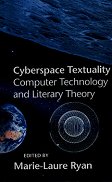 Aarseth, Espen.
"Aporia and Epiphany in Doom and The Speaking Clock."
Cyberspace Textuality: Computer Technology and Literary Theory. Ed.
Marie-Laure Ryan. Bloomington: U of Indiana Press, 1999. 31-41.
Aarseth, Espen.
"Aporia and Epiphany in Doom and The Speaking Clock."
Cyberspace Textuality: Computer Technology and Literary Theory. Ed.
Marie-Laure Ryan. Bloomington: U of Indiana Press, 1999. 31-41. Aarseth, Espen.
"Aporia and Epiphany in Doom and The Speaking Clock."
Cyberspace Textuality: Computer Technology and Literary Theory. Ed.
Marie-Laure Ryan. Bloomington: U of Indiana Press, 1999. 31-41.
Aarseth, Espen.
"Aporia and Epiphany in Doom and The Speaking Clock."
Cyberspace Textuality: Computer Technology and Literary Theory. Ed.
Marie-Laure Ryan. Bloomington: U of Indiana Press, 1999. 31-41.
Argument
". . . that new media call for new perspectives and conceptual frameworks; and that we must step back from our theories if we are to see something not already inscribed in them" (32). He then goes on to propose his new perspective and conceptual framework: ergodic discourse.
Definition of "Ergodic Discourse":
"Ergodic is appropriated from physics, and it is constituted by the two Greek words Ergos, "work," and Hodos, "path or road," and in this context it is used to describe a type of discourse whose signs emerge as a path produced no a non-trivial element of work. Ergodic phenomena are produced by some kind of cybernetic system, i.e. a machine (or a human) that operates as an information feedback loop, which will generate a different semiotic sequence each time it is engaged. . . "
"The experienced sequence of signs does not emerge in a fixed, predetermined order decided by the instigator of the work, but is instead one actualization among many potential routes within what we may call the *event space* of semio-logical possibility. This event space is determined by the content and the infrastructure of the ergodic system, which means that, for every individual system, we have, to some degree, an individual medium, and not just an individual message. To complicate matters, in its potential for reproducing itself differently every time, the ergodic work is individualized or quasi-individualized on the audience level, in that different audiences at different times may have experienced very few (if any) of the same sign vehicles" (33).
Summary of Characteristics of Ergodic Discourse
Examples of Ergodic Art
The Time Element in Ergodic Works
Narrative works contain 2 types of time: 1) the time of the tale 2) the time of the teller/telling
Ergodic works contain 3 types of time: 1 and 2 from above + the "event time" . In ergodic works the 3 times function as a basic structure for a dialectic between aporia (gaps hindering interpretation) and epiphany (moments of insight leading to overcoming gaps).
What Aarseth's theory means for a critique of electronic lit
A. Neutralizes Janet Murray's critique of electronic literature by:
B. Provides a new framework with which to discuss electronic literature on its own terms from its own elements rather than from a traditional literary viewpoint
C. Offers a method for delineating between various types of electronic art forms
D. Does a good job describing the 3rd dimension of cyberspace